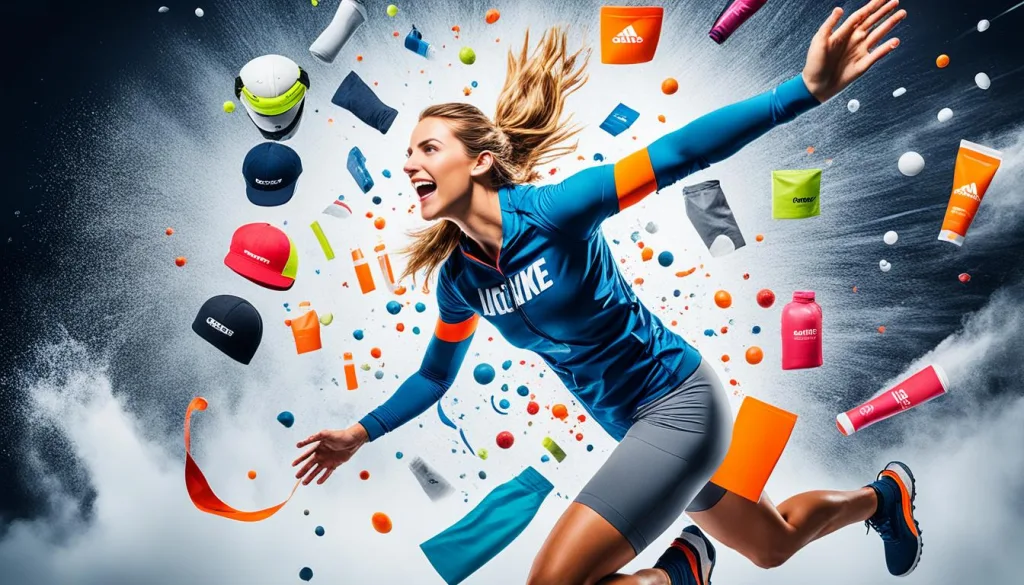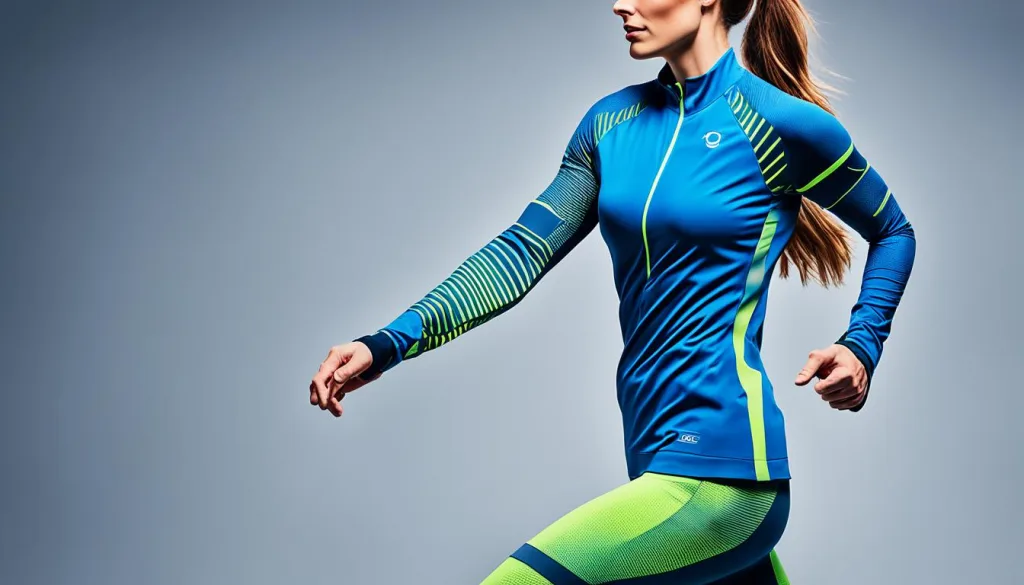Consumer Response to Sportswear Marketing Campaigns
Connect With Us Today
Consider us for your next production run. Why wait? Send us your questions here.
The world of sportswear marketing is constantly changing. This shift is affecting how people think and act towards these brands. Luxury sportswear companies are finding new ways to appeal to people. They focus on what people want, enjoy, and the status they get from buying these products. These strategies help increase the chance of people buying and spending more. It’s very important for brands to understand how marketing changes customer actions. This is especially true in a competitive market where teaming up with other brands is often a good move.
Key Takeaways
- The luxury fashion market’s significant value influences consumer spending behaviors1.
- Effective sportswear marketing must address utilitarian, hedonic, and symbolic benefits to impact consumer attitudes1.
- Co-branding has emerged as a leading strategy to elicit positive consumer responses in the luxury segment1.
- Social media plays a crucial role in sportswear brand awareness and engagement2.
- An understanding of demographics such as income and education level is crucial for tailored marketing campaigns1.
- Consumer purchase intentions are significantly shaped by the alignment of product benefits with their personal values1.
The Psychology of Sportswear Brand Engagement
People love sportswear brands for more than just how they look. It’s also about feeling connected on a deeper level. Brands work hard through ads and building strong images to win over their fans. This creates a special bond based on shared values and beliefs.
Understanding Brand Love and Loyalty in Sportswear
When people stick with their favorite sportswear brands, it’s a big deal. They see these brands as a part of who they are. Even when times got tough in 2020, and money for sports ads fell to $29 billion, fans stayed true to brands that matched their identity3.
Assessing the Impact of Brand Personalities
The personality of a sportswear brand can change how people see it. Brands that are real, inspire, and help people aim higher are more loved. This is clear when brands make memorable experiences for customers. It’s especially important for smaller brands trying to leave a big mark on people’s hearts3. Research shows social media helps spread the word about what these brands stand for4.
Consumer Perception of Sportswear Authenticity
These days, buyers really care if sportswear brands are being true to themselves. When a brand feels real, people are more likely to buy. Instagram shows that being genuine draws more attention, as explained in research about how people interact with these brands online4.

Let’s take a closer look at how sports sponsorships and customer interest have changed in different places:
| Region | 2018 Sports Sponsorship Growth | Consumer Engagement Rates |
|---|---|---|
| Asia Pacific | 5.7% Increase ($16.6 billion) | Surged in parallel with sponsorship growth3 |
| Global | Decrease to $29 billion by 2020 | Steady consumer loyalty despite economic challenges34 |
Trends Transforming the Sportswear Industry
The sportswear industry is experiencing fast changes. This is due to a mix of industry trends, fashion trends, and consumer preferences. More people are moving to cities. In 2019, over half the world’s population lived in urban areas5. People now want sportswear that is both useful for sports and stylish for daily wear.

Even though the market saw a 13% drop in revenue due to COVID-195, the sportswear industry is bouncing back. It’s expected to grow from USD 193.89 billion in 2023 to USD 305.67 billion by 20305. North America is leading, with a market size of USD 83.04 billion in 20225. But, Asia-Pacific will see the fastest growth rate from 2023 to 20326.
Big brands like Puma SE, Adidas AG, and Lululemon Athletica Inc. are investing in new products6. They’re putting money into research to stay ahead and meet the needs of different customers6. The focus is on the apparel sector, catering to a wide range of activities and lifestyle needs6.
- Investing in digital transformations is changing the game. It uses new tech and smart modeling to open up revenue opportunities7.
- Many millennials are willing to share their data for custom deals. Plus, most people like ads that match their interests7.
- Rolling out digital plans in stages helps companies integrate tech smoothly. It matches company goals and builds a tech-savvy team7.
But, the sportswear industry faces problems too. In 2020, global shipping dropped by 4.1%5. Plus, counterfeit goods made up 3.3% of world trade5. This underlines the importance of genuine products and efficient supply chains. Brands are working to improve their online stores and shopping experiences. They want to build a solid relationship with their customers.
In the end, the most successful sportswear brands will be those that can adapt. They need to keep up with changing customer wants and tech advancements. At the same time, they must not forget the importance of being sustainable and ethical in their business practices.
Consumer Response to Sportswear Marketing Campaigns
Studying how people react to sportswear ads shows the link between advertising impact and buying habits. Big names like Nike and Polo shine in this area by turning their clothes into a key marketing tool8. They tap into a truth – modern shoppers love not just the product, but the story and lifestyle it sells. This approach is backed by many customer stories8
- Nike connects deeply with people’s emotions8.
- Polo, Adidas, and Under Armour focus on high quality and great design8.
- Wearing branded sportswear spreads the brand message for free8.
Customers often mention how wearing certain brands makes them feel closer to their goals8. Nike’s tie to elite sports success, for instance, boosts its image. This directly feeds into greater brand devotion8.
| Marketing Element | Role in Consumer Engagement | Example Brands |
|---|---|---|
| Emotional Connection | Selling a lifestyle, not just a product | Nike8 |
| Brand Storytelling | Defining a brand through narrative | Polo, Under Armour8 |
| Quality and Design | Ensuring product and packaging excellence | Adidas8 |
Staying ahead in sportswear marketing means valuing quality packaging and unique labels too. They’re powerful marketing tools. The back-and-forth between what customers think and what brands do keeps the industry moving. It highlights how sportswear campaigns affect customer views in big ways8.
Dissecting the Efficacy of Anti-Consumption Marketing
Patagonia’s bold anti-consumption marketing initiative really stands out today. It challenges the usual way we buy and supports talking about lasting practices. This ties closely to the United Nations’ goal for responsible consumption by 20309.
Looking at Patagonia’s “Don’t Buy This Jacket” campaign shows a mix of strategy and how we act as consumers9.
Case Study: Patagonia’s “Don’t Buy This Jacket” Campaign
Patagonia’s campaign was different. It made people think about their choices and the environment9. This rare idea has made people see Patagonia as a leader in green thinking. It also fills a gap in understanding how to consume responsibly9.
Psycho-Social Responses to Anti-Consumption Messages
This campaign sparked a mix of feeling informed and ready to act. Yet, a study showed folks often don’t know enough about green habits. This causes a gap between knowing and doing9.
Patagonia tried to fix this with its campaign. It aimed to teach and inspire smarter, value-based choices about what we buy9.
Impact on Purchase Intentions and Consumer Attitudes
Here, we talk about buying intentions and how Patagonia’s campaign has shifted attitudes10. This new way of marketing could change more than just the environment. It might also impact areas like health and politics, showing a new way to influence what we buy9.
FAQ
How does sportswear marketing influence consumer attitudes and behaviors?
What role do brand love and loyalty play in sportswear brand engagement?
How do brand personalities impact consumer attitudes and behaviors in the sportswear industry?
Why is authenticity important in sportswear marketing?
What are the current trends and transformations in the sportswear industry?
How do different advertising strategies impact consumer perceptions and purchasing decisions?
How does consumer feedback shape future sportswear marketing strategies?
What is anti-consumption marketing and how does it impact the sportswear industry?
Can you provide an example of a successful anti-consumption marketing campaign in the sportswear industry?
How do consumers respond to anti-consumption messages in sportswear marketing?
What impact do anti-consumption messages have on purchase intentions and consumer attitudes towards sportswear brands?
Source Links
- https://www.sciencedirect.com/science/article/abs/pii/S0148296316304271
- https://thesocialshepherd.com/blog/social-media-strategy-fashion-brands
- https://www.frontiersin.org/journals/psychology/articles/10.3389/fpsyg.2021.677137/full
- https://www.sciencedirect.com/science/article/pii/S0148296321002307
- https://www.fortunebusinessinsights.com/sportswear-market-102571
- https://www.marketresearchfuture.com/reports/sportswear-market-16113
- https://www.deloitte.com/global/en/Industries/tmt/perspectives/gx-digital-transformation-and-future-changes-in-sports-industry.html
- https://www.theadairgroup.com/blog/how-clothing-became-a-marketing-medium/
- https://www.mdpi.com/2071-1050/15/23/16442
- https://www.ncbi.nlm.nih.gov/pmc/articles/PMC5245110/
Latest News
How Collaboration Shapes Consumer Preferences in Sportswear
Navigating Consumer Rights and Warranties in Sportswear Sales
Artificial Intelligence in Fashion Forecasting and Trend Analysis
The Shift Towards Inclusive Sizing in Sportswear: Consumer Reactions
The Global Expansion of Luxury Sportswear Brands
From Sketch to Gym: The Design Process of Fashionable Sportswear
Understanding the Role of Trade Associations in Sportswear Compliance
How Economic Trends Influence Consumer Spending on Sportswear
Learning from Successful Global Market Entries
Best Practices for Managing Cross-Cultural Teams
Using Technology to Fight Counterfeit Fashion Products
Carbon Nanotube Fabrics for Superior Strength and Flexibility
The Growth of Fitness Tracking Apparel in Health and Wellness
Exploring the Influence of Social Proof in Sportswear Purchasing
Strategies for Managing Compliance in a Multinational Operation
Trends in Global Footwear: Performance Meets Lifestyle
The Role of Artificial Intelligence in Tracking Supply Chain Operations
Evaluating the Success of Sportswear Collaborative Projects
Evaluating the Potential of Emerging Markets
Global Shifts Towards Gender-Neutral Sportswear
Share This Article
Latest Articles



















